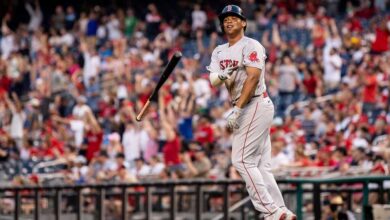

Most Americans not living under rocks know the Boston Red Sox came back from a 5-0 deficit to defeat the Detroit Tigers in game two of the ALCS Sunday night. For the Tigers, it was a meltdown of almost epic proportion. The Red Sox Win Expectancy entering the eighth inning was just three percent. For the Red Sox, it was another example of a great hitter, David Ortiz, being great in the playoffs once again.
With the Tigers snatching defeat from the jaws of victory, players and fans alike can’t help but talk about how the Sox have seized momentum in the ALCS. Being the cold-hearted and unfeeling curmudgeon that I am, I can’t help but disagree.
Sure, each team has scored six runs in the series, but the Tigers have dominated. Red Sox hitters have managed just a .234 wOBA, while striking out in 46.4 percent of their plate appearances. Tigers hitters have compiled a .324 wOBA, striking out in 16.7 percent of plate appearances.
Let’s put it this way. A .324 wOBA is a shade above the MLB average for 2013. Kansas City Royals shortstop Alcides Escobar had the lowest wOBA among qualified hitters at .247.
Earl Weaver, the famed Baltimore Orioles manager, once said that momentum is the next day’s starting pitcher. Well, in that case, the Tigers are sending Justin Verlander to the mound in game three.
While Verlander supposedly had an “off-year” in 2013, he was still a top-notch pitcher, ranking seventh among all pitchers in WAR. He posted strikeout and walk rates of 23.5 percent, and 8.1 percent, respectively.
This postseason, Verlander has been nearly unhittable. Featuring a fastball that has averaged over 95 miles per hour, Verlander has thrown 15 scoreless innings, allowing just six hits, with two walks and 21 strikeouts. Hitters have whiffed at 21.5 percent of his fastballs, and. Over 40 percent of swings at Verlander’s fastball have resulted in whiffs this postseason.
It’s almost as if he doesn’t need them, but Verlander’s secondary pitches have been very effective as well. While “getting stronger as the game goes on” is often a meaningless cliche, Verlander’s fastball velocity has increased in innings one through seven.
So, you get the point: Verlander is a tough customer. His opponent, John Lackey, has been surprisingly good in his return from Tommy John surgery. But, there are signs he’s tiring in his first full season since 2010. His ERA and FIP were up slightly in August and September, and his fastball velocity was down a little.
In addition, the Tigers will have home field advantage over the next three games. Like most teams, they fare a lot better at home. Having home field advantage generally adds five percentage points to a team’s chances of winning, roughly the same effect that replacing Torii Hunter with Mike Trout would have.
Maybe I’ve painted a pretty convincing picture in favor of the Tigers in game three. Of course, baseball doesn’t like to lend itself to predictability. Freddy Garcia went toe-to-toe with Clayton Kershaw just last week, and Lackey is a lot better than Garcia.
Anything could happen. However, I believe any momentum the Red Sox have goes away once Justin Verlander takes the mound Tuesday night.





